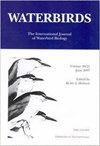Sex Determination of Juvenile Harlequin Ducks Histrionicus histrionicus Using Morphometric Data
IF 0.6
4区 生物学
Q3 ORNITHOLOGY
引用次数: 1
Abstract
Abstract. Harlequin Ducks (Histrionicus histrionicus) were captured on breeding streams in Alberta, Canada from 1995–2018. Measurements for exposed culmen, tarsus bone, and wing length, and mass, were significantly larger for adult males than those for adult females, while only tarsus was significantly larger for male ducklings than for females. The repeatability of tarsus and culmen measurements across time for the same individuals was significantly different from 0, indicating high consistency. We used logistic regression of culmen and tarsus length of adult ducks to identify the best model to predict the sex of adults, then constructed a classification and regression tree to predict the sex of a test set of juveniles that had been banded and sexed as ducklings but that were sexed by plumage when resighted as adults. The model with the highest accuracy (96.9%) and lowest number of individuals in the zone of uncertainty (thus sexed as unknown) was tarsus < 37.5 mm (classify as females) or ≥ 38.0 mm (classify as males). Individuals in the zone of uncertainty with a penis sheath should be sexed as male, but individuals without a penis sheath that do not match the appropriate tarsus length should be sexed as unknown.利用形态计量学数据确定小丑鸭幼鸭的性别
摘要1995年至2018年,在加拿大阿尔伯塔省的繁殖溪流中捕获了丑角鸭(Histrionicus Histrionicus)。成年雄鸭暴露的鼻梁、跗骨、翅膀长度和质量的测量值明显大于成年母鸭,而只有雄鸭的跗骨明显大于母鸭。同一个体的跗关节和跗关节在不同时间测量的可重复性从0显著不同,表明高度一致性。通过对成年鸭鼻梁和跗趾长度的逻辑回归,确定了预测成年鸭性别的最佳模型,然后构建了分类回归树,对一组雏鸭的性别进行了预测,这些雏鸭在雏鸭时期被带状划分性别,但在成年后被羽毛划分性别。准确度最高(96.9%)和不确定区(因此性别为未知)个体数最少的模型是跗骨< 37.5 mm(归类为雌性)或≥38.0 mm(归类为雄性)。在不确定区域的有阴茎鞘的个体应被性别定为男性,但没有阴茎鞘的个体如果与适当的跗骨长度不匹配,则应被性别定为未知。
本文章由计算机程序翻译,如有差异,请以英文原文为准。
求助全文
约1分钟内获得全文
求助全文
来源期刊

Waterbirds
生物-鸟类学
CiteScore
1.30
自引率
0.00%
发文量
0
审稿时长
6-12 weeks
期刊介绍:
Waterbirds is an international scientific journal of the Waterbird Society. The journal is published four times a year (March, June, September and December) and specializes in the biology, abundance, ecology, management and conservation of all waterbird species living in marine, estuarine and freshwater habitats. Waterbirds welcomes submission of scientific articles and notes containing the results of original studies worldwide, unsolicited critical commentary and reviews of appropriate topics.
 求助内容:
求助内容: 应助结果提醒方式:
应助结果提醒方式:


